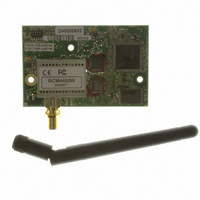20-101-1221 Rabbit Semiconductor, 20-101-1221 Datasheet - Page 29

20-101-1221
Manufacturer Part Number
20-101-1221
Description
RCM4400W (JAPAN TELEC CERTIFIED)
Manufacturer
Rabbit Semiconductor
Series
RabbitCore®r
Datasheet
1.20-101-1202.pdf
(126 pages)
Specifications of 20-101-1221
Frequency
2.4GHz
Modulation Or Protocol
802.11 b
Power - Output
16dBm
Voltage - Supply
3.3V
Current - Receiving
450mA
Current - Transmitting
450mA
Data Interface
Connector, 2 x 25 Header
Memory Size
512K Flash, 1MB SRAM
Antenna Connector
SMA
Operating Temperature
-20°C ~ 85°C
Package / Case
Module
Lead Free Status / RoHS Status
Lead free / RoHS Compliant
Applications
-
Sensitivity
-
Data Rate - Maximum
-
Other names
316-1147
•
•
•
OEM User’s Manual
SIMPLE3WIRE.C
communication. Lower case characters are sent on TxC, and are
received by RxD. The received characters are converted to upper case
and are sent out on TxD, are received on RxC, and are displayed in the
Dynamic C
To set up the Prototyping Board, you will need to tie TxD and RxC together on the
RS-232 header at J4, and you will also tie RxD and TxC together using the jumpers
supplied in the Development Kit as shown in the diagram.
SIMPLE5WIRE.C
with flow control on Serial Port D and data flow on Serial Port C.
To set up the Prototyping Board, you will need to tie TxD and RxD
together on the RS-232 header at J4, and you will also tie TxC and
RxC together using the jumpers supplied in the Development Kit as
shown in the diagram.
Once you have compiled and run this program, you can test flow con-
trol by disconnecting the TxD jumper from RxD while the program is running. Charac-
ters will no longer appear in the
connected back to RxD.
If you have two Prototyping Boards with modules, run this sample program on the
sending board, then disconnect the programming cable and reset the sending board so
that the module is operating in the Run mode. Connect TxC, TxD, and GND on the
sending board to RxC, RxD, and GND on the other board, then, with the programming
cable attached to the other module, run the sample program. Once you have compiled
and run this program, you can test flow control by disconnecting TxD from RxD as
before while the program is running. Since the J4 header locations on the two Prototyping
Boards are connected with wires, there are no slip-on jumpers at J4 on either Prototyping
Board.
SWITCHCHAR.C
ASCII string on Serial Ports C and D. It also displays the serial data received from both
ports in the
To set up the Prototyping Board, you will need to tie TxD and RxC
together on the RS-232 header at J4, and you will also tie RxD and
TxC together using the jumpers supplied in the Development Kit as
shown in the diagram.
Once you have compiled and run this program, press and release
switches S2 and S3 on the Prototyping Board. The data sent between the serial ports
will be displayed in the
STDIO
STDIO
—This program demonstrates transmitting and then receiving an
—This program demonstrates basic RS-232 serial
—This program demonstrates 5-wire RS-232 serial communication
window.
window.
STDIO
window.
STDIO
window, and will display again once TxD is
23

















